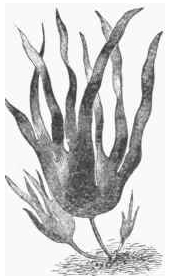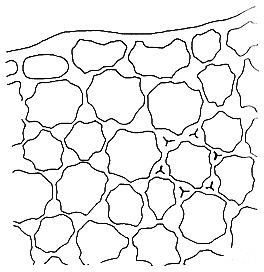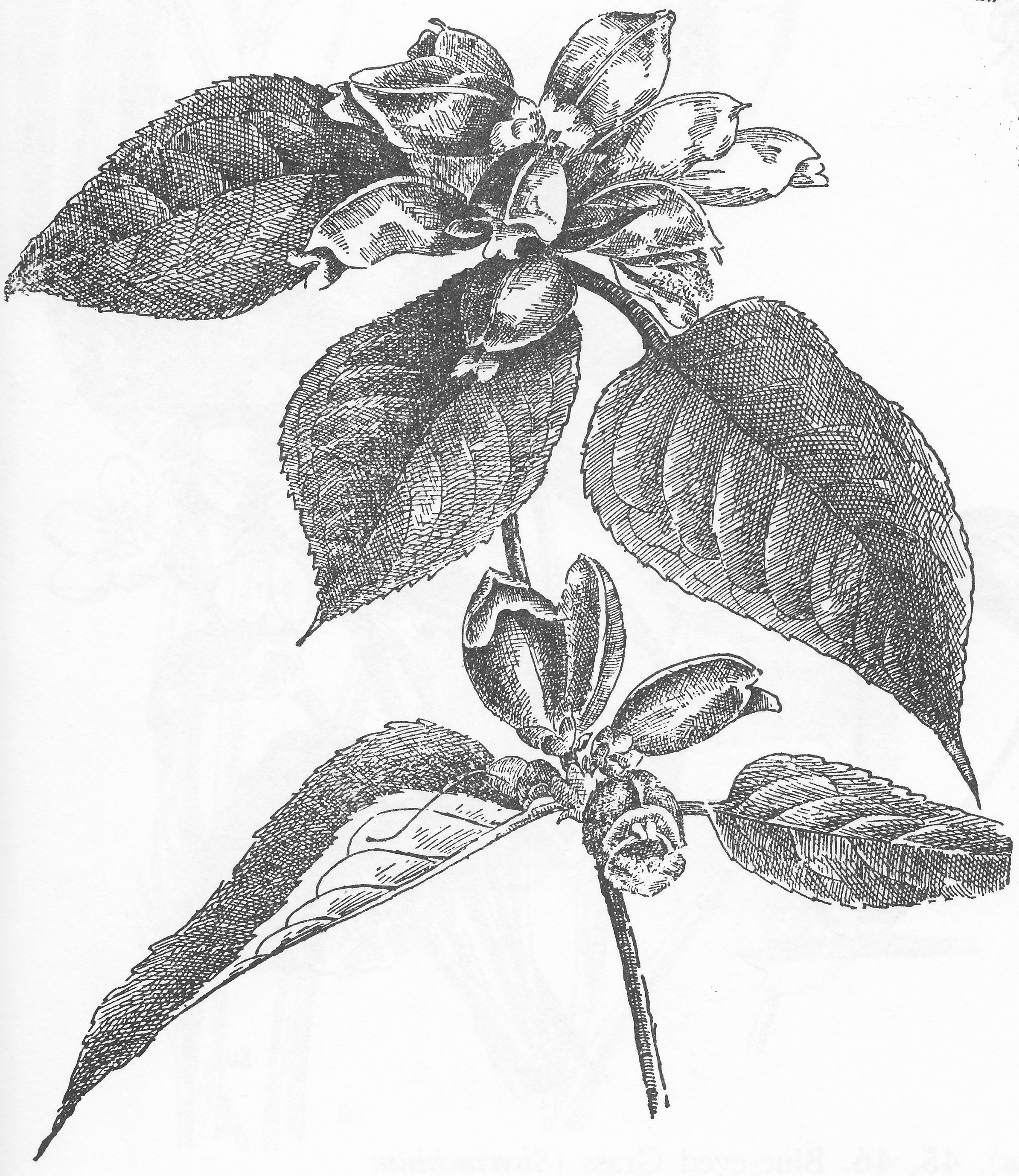take-all n. a fungal disease which can infect the roots and lower stems of wheat or triticale crops (Gaeumannomyces graminis (Sacc.) Arx & D.L.Olivier var. tritici J.Walker, of divisio Ascomycota), and which is capable of spreading from plant to plant over an extensive area. It leaves the lower stems and roots shiny black, and seriously interferes with water uptake.
ta·ne·ka·ha (tä´ne kä´hä) n. a conifer native to New Zealand (Phyllocladus trichomanoides D.Don, of the Phyllocladaceae), bearing whorls of phylloclades; celery-leaved pine. [Maori]
tang (tang) n. a collective name for any large, coarse seaweed; wrack. [ME < ON tang seaweed]
tan·gle¹ (tang´gəl) n. v.t. —n. 1 either of two species of seaweed (Laminaria digitata (Huds.) J.V.Lamour. or L. saccharina (L.) J.V.Lamour., both of divisio Phaeophycophyta), both of which bear fronds which are edible while young. 2 tang; wrack. 3 an intertwisted mass of branches and foliage, or of roots. 4 a complicated and muddled assemblage. —v.t. 1 intertwist confusedly with other branches of the same or another plant. 2 collectively intertwist. [(n.) cf. Norwegian taangel, Icelandic þöngull; (v.) < ME tagil < Sw. taggla disarrange, bring into disorder]
tan·gle² (tang´gəl) n. Scot. a plant having a long, winding stalk which can become entwined, whether a pondweed or a sprawling, creeping shrub. [< ON tang, assimilated to DANGLE]
ta·pa (tä´pə) n. 1 a papery cloth fashioned from the inner bark of a Polynesian tree; barkcloth. 2 the paper mulberry (Broussonetia papyrifera (L.) Vent., of the Moraceae), from whose inner bark this cloth is fabricated. [Marquesan/Tahitian]
tap·i·o·ca (tap´ē ō´kə) n. a starchy residue of hard white grains, derived from cassava roots. It can be cooked in water to prepare a pudding. [< Tupi-Guaraní tipioka < tipi dregs + og, ok squeeze out]
tea drunk (tē drənk) adjectival phrase. an altered mental state induced by drinking quantities of high quality teas, particularly green tea, pu-erh, and oolong. It is said to induce an euphoric but calm and meditative state, likely a result of a combination of several compounds in the tea, among them caffeine and L-theanine. —tea drunkenness, noun phrase.
tea garden n. a public garden in which tea is served to visitors.
teak (tēk) n. 1 a tree native to the east Indies (Tectona grandis L.f., of the Lamiaceae), which yields a very hard and durable wood useful for furniture and shipbuilding. 2 the wood of this tree. 3 any of the 3 congeneric species, also native to adjoining territory. —adj. 1 fabricated of teak wood. 2 of the same yellowish-brown colour as this wood. [< ME teke < Port. teca < Malayalam tēkka < Tamil tēkku]
tea tree n. 1 any of various species of the genus Leptospermum J.R.Forst. & G.Forst. (of the Myrtaceae), shrubs or small trees mostly endemic to Australia, and which yield an antimicrobial oil. 2 any of various species of the genus Melaleuca L. (of the Myrtaceae), also shrubs and trees mostly endemic to Australia and adjacent countries, and which similarly yield antifungal and antimicrobial oils. [from leaves suitable for an herbal tea rich in vitamin C]
ted¹ (ted) v.t. ted·ded, ted·ding. lay out or strew (grass, hay, or straw) to dry, and turn it, until properly dry for use as bedding or floor covering. [< Icelandic tęðja spread manure]
ted² (ted) v.t. ted·ded, ted·ding. put serrations or fine teeth upon (the cutting blade of a sickle). [? < ME teth teethe] —ted´der, n.
teg·u·la (teg´ū lə) n. -læ [-lē]. in flowers of the Orchidaceae, a stalk deriving from tissue of the rostellum to which the pollinia are attached. [< L tēgula tile]
teg·ule (teg´ūl) n. -ules, -u·læ [-lē]. in inflorescences of the Asteraceae, any of the numerous bracts which subtend an individual inflorescence (capitulum); palea; phyllary. [< L tēgula tile]
teg·u·ment (teg´yu̇ mənt) n. a natural outer covering of a body, as the coat of an ovule or seed; integument; tegmen. [< L tegumentum covering]
tel·lur·ic (te lü´rik) adj. 1 of, or deriving from, the soil. 2 of, or deriving from, the Earth. [< L tellūs earth + ME -ic (< L -icus adjectival suffix)]
te·lome (tē´lōm´) n. the hypothetical origin for many structures located at distal ends of branches, comprising a simple terminal branchlet – now lost to archæological evidence – deriving from repeated dichotomous branchings. [< G telom < Gk. télos τέλος end + -ōma -ωμα tumour, body]
te·na·cious (te nā´shəs) adj. holding or grasping firmly. [< L tenaci- (< tenax holding fast) + -ōsus pertaining to, prone to]
ten·dril (ten´drəl) n. a part of a rachis or leaf blade modified into a slender, twining holdfast; cirrus. It allows climbing plants to attach themselves to support. [< F tendrillon shoot, sprout; ult. < L tener tender] —ten´dril·ous, adj.
ten·drilled (ten´drəld) adj. possessing tendrils. —comb.form, suffix. (often, -ten·drilled) possessing tendrils of a form or number identified by a prefix.
ten·ta·cle (ten´tə kəl) n. 1 tendril. 2 glandular hair, especially upon a leaf, as in sundew. [< L tentaculum < tentare feel, try] —ten·tac´u·lar, adj.
te·o·sin·te (tā´ō sin´tā) n. a robust grass native to Mexico (Zea mays L. subsp. mexicana (Schrad.) Iltis, of the Poaceae), and regarded as the probable source of the closely-related maize. It is cultivated as forage. [< F téosinté < Sp. < Nahuatl teōcintli < teōtl god + cintli dried ear of maize]
te·re·binth (te´rə binth´) n. a small tree native to the Mediterranean (Pistacia terebinthus L., of the Anacardiaceae), bearing pinnate leaves, and which may be used as a source of turpentine; turpentine tree. [ME < OF terebinte < L terebinthus < Gk. terebinthos τερέβινθος]
tet·rad (tet´rad) n. of spores and (in some cases) other reproductive cells, a body consisting of and dispersed as four similar adjoining cells in a tetragonal arrangement. Such spores frequently bear trilete marks. [< Gk. tetrados τετράδος group of four]
tet·ra·dy·na·mous (tet´rə dī´nə məs) adj. of a flower, bearing 4 long and 2 short stamens, as is frequently the case in familia Brassicaceae. [< Gk. tetras τετράς four + dynamikos δυναμικός efficacious]
te·tras·ti·chous (ti tras´ti kəs) adj. bearing leaves or other organs in four rows evident along a stem or axis; decussate. [< NL tetrastichus < Gk. tetrástichos τετράστιχος of four rows] —te·tras´ti·chous·ly, adv.
thick·et (thik´it) n. 1 a dense group of shrubs and/or trees. 2 a derogatory name for a shrubbery or wood. [< OE þiccet < þicce thick + -et noun suffix] —thick´et·ed, adj. —thick´et-for´ming, adj. —thick´et·y, adj.
thin (thin) v.t. thinned, thin·ning. to prune branches of trees or shrubs, or to remove some plants from a cultivated area, to allow greater light penetration to the ground. —v.i. become lesser in size or in density with distance or with time.
thor·ough·wort (thər´ō wôrt´) n. U.S. any of a number of herbs of the genus Eupatorium L. (of the Asteraceae), principally those native to the Americas; joe-pye weed.
thrive (thraiv) v.i. throve or thrived, thri´ven or thrived. of an individual or community, grow vigourously, prosper and flourish. [< ON þrīfask] —thri´ving, adj. —thri´ving·ly, adv.
ti·a·ré (tē ä ɾā´) n. the national flower of French Polynesia (Gardenia taitensis DC., of the Rubiaceae), a shrub of coastal uplands which bears fragrant white rotate flowers. It has been introduced widely among South Pacific islands. [< F < Polynesian]
till·er¹ (til´ər) n. v.i. —n. 1 a lateral shoot which arises adjacent to the base of the established parent plant. 2 a sapling which arises from the base of a tree. —v.i. produce such lateral shoots. [< OE telgor twig, shoot < ON tjalga branch < Gmc.]
till·er² (til´ər) n. 1 one who tills the land; farmer. 2 a machine or implement for breaking up congealed soil; cultivator. [< ME tiliere < OE tilia]
tim·o·thy (tim´ə thē) n. a perennial grass (Phleum pratense L., of the Poaceae), native to Britain and Europe but planted (ca. 1720) in Southern Carolina of the USA and often cultivated as fodder. [< Timothy Hansen, the farmer who brought it into cultivation in North America]
toad·flax (tōd´flaks´) n. 1 a common weed spread from Europe having yellow-and-orange flowers (Linaria vulgaris Mill., of the Scrophulariaceae). 2 certain other closely-related genera and species (of Linaria Mill., as well as of Chaenorhinum (DC.) Rchb., and Cymbalaria Hill, all of the Scrophulariaceae), not all sharing the upright monopodial growth form of the original. All bear a characteristic two-lobed swelling upon the lower lip of the flower, called a palate. [suggested by its flax-like leaves]
toft (toft) n. 1 in mediæval parlance, a small enclosed garden near a house, as opposed to the larger croft. 2 the land of a house and its immediate outbuildings. [OE]
tol·er·ance (täl´ə rəns´) n. 1 the ability to tolerate, endure, and – potentially – benefit from environmental factors which are normally considered harmful to organisms. 2 a diminution in the harmful effects experienced by an organism from repeated exposure to a physical or chemical factor. [ME < OF < L tolerantia endurance] —tol´er·ant, adj.
tol·er·ate (täl´ə rāt´) v.t. endure and allow continued exposure to a harmful environmental factor. [< L tolerare]
to·ma·ti·llo (tō´mə tē´lyō) n. 1 a cultivated annual herb (Physalis ixocarpa Brot. ex Hornem., of the Solanaceae), native to Mexico, and producing black-spotted yellow flowers bearing juicy edible green or bluish berries enclosed in papery calyces; ground cherry; husk tomato. The fruit is used for jams and sauces. 2 goji; wolfberry. —adj. of, or pertaining to, or flavoured with, the tomatillo. [< Sp. tomatillo small tomato < Nahuatl tomātl fat water]
tooth·wort (tüth´wôrt) n. 1 any of a small number of species of the parasitic genus Lythraea L. (of the Orobanchaceae), producing an upright one-sided spike of small purple flowers with creamy-white tubular calyces (suggestive of teeth), and lacking chlorophyll. This genus generally grows upon the roots of certain trees. 2 the single species Dentaria incisifolia Eames, as well as many of a closely-related subset of species of genus Cardamine L. (all of the Brassicaceae), native to North America and Eurasia, and which may bear toothlike enations from their creeping rhizome; crinkleroot; pepperroot. The rhizome is edible, and has also shown utility for treating certain medical complaints.
tor·men·til (tôr´mən til´) n. a perennial subshrub native to temperate Eurasia (Potentilla erecta (L.) Raeusch., of the Rosaceae), growing from a stout woody rhizome which produces a red dye, and also compounds suitable as an astringent and a treatment for diarrhea; bloodroot; septfoil. [ME < F tormentille < Med.L tormentilla < tormentum tension, pressure, torment + -ill diminutive]
to·rose (tô´rōs) adj. of a cylindrical or ellipsoid body (such as a capsule or legume), sequentially swollen and constricted; lomentaceous; torulose. [< L torōsus < torus swelling + -osus prone to, possessing]
tor·u·lose (tôr´ū lōs) adj. of a cylindrical or ellipsoid body (such as a capsule or legume), sequentially swollen and constricted; lomentaceous; torose. [< L torulus small torus]
tract (trakt) n. 1 a large, but undefined, area of land, or of land and water. 2 an extent of time. [< L tractus drawing < trahere draw + -tus v. suffix for action]
trans·la·tor (trans lā´tər) n. a narrow strand of stigmatic secretions which connects pollinia to a corpusculum, in flowers of such familia as Apocynaceae and Asclepiadaceae, but not in Orchidaceae. [< LL translātor one who transfers a thing]
tree farm n. v. tree farmed, tree farm·ing. —n. a privately owned area in which trees are grown under a system of forest management. —v. to engage in the cultivation of a forest area specifically for the production of trees; to cultivate specific tree species in a defined terrain.
tri·col·pate (trī´kōl´pāt) adj. of angiosperm pollen, having or bearing three colpi, characteristic of many dicotyledon genera. [NL < L tri- three + LL colpus strike, hit]
tri·fid (trif´id or trī´fid) adj. split about midway into three lobes. [< L trīfidus divided into three, on pattern of bifid]
tri·gone (trī´gōn´) n. -go·nes (-gō´nēz). an area of thickened cell wall material where three or more cells adjoin, in many cases distinctive. [< F < L trigōnum triangle]
tris·ti·chous (tris´ti kəs) adj. bearing leaves in three rows evident along a stem or axis. [< Gk. trístichos τρίστιχος of three rows] —tris´ti·chous·ly, adv.
tri·to·ma (tri´tə mə) n. an annual or perennial herb bearing striking yellow to red flowering spikes (Kniphofia Moench, of the Asphodelaceae) native to Africa, and now cultivated elsewhere under many cultivars; poker plant. [< NL Tritoma Ker Gawl. (of the Liliaceae) < Gk. trítomos τρίτομος thrice-cut + L -a fem. sing. noun suffix]
trow·el (trou´əl) n. a small hand-held tool used to dig plants up by the roots, consisting of a curved shield-shaped scoop and a handle. [ME < OF truele < Med.L truella, alteration of L trulla scoop, dim. of L trua skimmer]
trul·late (trul´āt) adj. of leaf blades, having a quadrangular outline acute at base and apex, and with angled margins just proximal to the midpoint. [< L trulla trowel + -ātus provided with]
tu·bu·lin (tū´bū lin) n. a protein dimer, composed of two distinct subunits (often labelled as α- and β-), instrumental in the function of microtubules. [NL < L tubulus small pipe or tube + -ina noun suffix denoting organic substances or compounds]
tul·si (tol´sē) n. an herb used as an herbal tea (Ocimum sanctum L., of the Lamiaceae), cosmopolitan in suitable tropical habitats; holy basil. [< Hindi tūlsī]
tum·mock (təm´ək) n. hillock. [< ScGael tom hillock + ME -ock dim. suffix]
tump (təmp) n. Brit. 1 a clump of trees, shrubs, or grass. 2 a small rounded hill; hummock. [cf. E tomb < L tomba < Gk. tymbos τύμβος tomb, tumulus]
tur·pen·tine (tėr´pən tīn´) n. 1 an oleoresin naturally produced by certain trees, particularly pines, and distilled to produce oil of turpentine and rosin. 2 oil of turpentine, a volatile compound much used in liniments and paints (C₁₀H₁₆). 3 Rare. turpentine tree. [ME < OF ter(e)bentine < L ter(e)binthina resina resin of the turpentine tree]
turpentine tree n. any of a variety of unrelated trees, among them the Mediterranean Pistacia terebinthus L. and P. palaestina Boiss. (both of the Anacardiaceae), as well as many conifers, particularly within genus Pinus L. (of the Pinaceae), all of which may serve as sources of turpentine.
tur·tle·head (tėr´təl hed´) n. any plant of a North American herbaceous genus (Chelone L., of the Scrophulariaceae), bearing spikes of purple or white bilabiate flowers said to resemble the head of a turtle; snakehead. [descriptive of the appearance of the flower]
tus·si·la·go (tus´ə lä´gō) n. an herbaceous, and invasive, perennial ruderal (Tussilago farfara L., of the Asteraceae), native to temperate Europe and Asia and now present in the Americas; coltsfoot. It is known to be an effective treatment (as tea or syrup) of respiratory infections, as well as in several other complaints, but contains tumorigenic pyrrolizidine alkaloids which may have adverse effects upon the liver, except in the cv. Wien, developed in Austria. It bears early flowers similar to the later dandelion, and ovate leaves much later. [< L tussis a cough + -agō induce]



